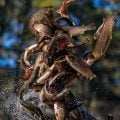How to Tie an Extended Body Isonychia Parachute
Producer: Tim Flagler
I can’t get enough of extended body flies. They’re fun to tie, look incredibly realistic and fish just great. They may take a little longer to tie but I believe they’re totally worth the extra effort.
To start, place a short, fine sewing needle into the jaws of your tying vise, with the point end out. Regular dubbing wax, although not essential, works well as a lubricant and aids in removal of the extended body once it’s complete.
For this size 12 Isonychia Parachute, I’m going to use small, clear stretch tubing. But medium will also work, particularly if you’re just starting out. Slide one end of the tubing over the needle. The small size takes a good bit of effort. With about 1/2” of tubing on the needle, snip the remainder off at the needle’s point. Continue slipping the tubing on to the needle until just the point is exposed, about like so.
For thread, I’m going to use UTC 70 Denier in blue dun, but black and maroon will also work just fine. After loading a bobbin with the thread, get it started close to the front edge of the tubing and take a few wraps rearward before snipping off the excess tag. Continue taking wraps rearward, almost to the back edge of the tubing then forward to about 1/4 of the way down the tubing.
Moose body hair is used for the tail of the fly. Snip a small clump free from the hide and strip out any shorter hairs or those that are exceedingly long. Place the hair tips first into a stacker and give them a good stacking. I like to trim the excess butt ends off even with the top of the stacker, then give it another rap or two. Open the stacker and retrieve the hair by the aligned tips with the fingers of your right hand then pass the clump to your left. Measure to form a tail about the same length as the tubing then start anchoring the hair with wraps of tying thread. Go out to the point of the needle then back down the tubing. You do want to take just a couple of wraps beyond the point of the needle so you have thread wraps all the way down to the moose hair. Continue taking wraps to build up the underbody of the fly. A drop of super glue, here Fly Tyer Z-ment, placed on the thread wraps at the very base of the tail is almost essential in terms of durability. Take thread wraps over top of the adhesive to help set it. You don’t want to use too many thread wraps here but you do want everything to be locked down well.
UV2 Fine & Dry Isonychia dubbing is used for the rest of the fly’s body, both the extended abdomen and the thorax. Pull an ample pinch free from the packet and use it to create a thin 3” long dubbing noodle on your tying thread, that’s tapered at both ends. Really try to keep the noodle slender. Start taking wraps so the dubbing begins right at the base of the tail. Then make touching wraps to the left to create the body of the fly. The length is really up to you on the extended body. I like them to be approximately the same length as the tail.
Get hold of your whip finish tool and use it to do a 5 or 6 turn whip finish right at the end of the body, seat the knot well and snip or cut your tying thread free. Firmly grip the body and give a little twist to pull it free from the needle. Snip off the excess butt ends of moose body hair. Set the extended body somewhere safe as they have a tendency to wind up on the floor or get lost on your tying bench.
For a hook, I’m going to use a Lightning Strike SE1 in size 12. After getting the hook firmly secured in the jaws of your tying vise, once again pick up your bobbin and this time get your thread started on the hook shank at the back edge of the eye and take a few wraps rearward before snipping off the excess tag. Continue taking thread wraps down the hook shank until your thread hangs at about the point.
Retrieve the extended body and lay it on top of the shank. Take nice tight wraps of tying thread to compress the tubing, thread wraps and moose hair. This will ensure that it can’t pull free or start to unravel. Use your tying scissors to snip the excess material off at a shallow angle then take thread wraps to cover up the snipped off ends.
Light gray Para Post wing material is used for the fly’s post. Lay one end of the material on top of the hook shank and take thread wraps to secure it a few eye-lengths back from the hook eye. After making sure it’s bound down really well, reach in with your tying scissors and snip the excess off close. Pull the post back and jam a few wraps underneath it to hold it up. Then start taking posting wraps up the material. When your post is about 1/4” tall, begin taking thread wraps back down. End with your tying thread on the hook shank immediately in front of the post.
A single feather from a Medium dun neck is used to hackle the fly. Make sure the fibers are the correct length, here, size 12, before plucking the feather free from the skin. After stripping off all the lower webby fibers from the stem, lay the feather with its dull side facing you at an angle against the post. Using the back edge of the hook eye as a guide, snip off any excess stem. Anchor the stem first to the near side of the hook then bring your tying thread around the wing post and take wraps up to anchor it there. Wrap down the post with your tying thread for the final time, making sure to get at least one full wrap around the body of the fly. End with your tying thread in front of the post.
Once again reach for the Isonychia dubbing and this time use it to create a slender noodle on your tying thread, about 1/2 the length of the previous one. Start taking wraps with the noodle so the dubbing begins at the back of the hook eye. Then take touching wraps rearward to build up the thorax of the fly. Make sure to get all the gray underbody thread covered up in the process. Go around the back of the post and leave your tying thread in front of it, on the near side of the hook.
Pull the hackle feather down to lightly crease its stem then take touching clockwise wraps down the post, ending at its base, 6 or 7 turns are generally plenty. Carefully take wraps of tying thread to secure the feather to the base of the post. The idea is to trap as few hackle fibers as you can in the process. Use the very tips of your tying scissors to snip the excess hackle feather off close.
Now’s a good time to trim the wing post off so it’s about the same length as the fly’s extended body. Again, reach for your whip finish tool and this time use it to do a 4 or 5 turn whip finish around the base of the post, seat the knot well and snip or cut your tying thread free. If you trapped any hackle fibers in the process, don’t sweat it. Just trim them off close and no one will be the wiser.
It’s a really good idea to add a drop of head cement to the thread wraps at the base of the post. Once it dries and contracts, it will greatly increase the fly’s durability.
And that’s the Extended Body Isonychia Parachute. As good as this fly looks in the vise, it fishes even better.
How to Tie an Egg-Laying Grannom (Caddis)
How to Tie an Ian's Brass Ass











